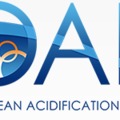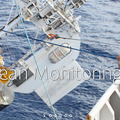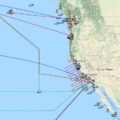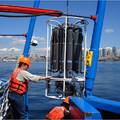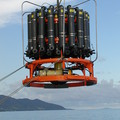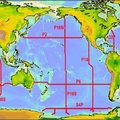The global re-occupation of hydrographic sections is necessary to quantify changes in storage and transport of heat, fresh water, carbon dioxide, and related parameters.
Ship-based hydrography is the only method for obtaining high-quality, high spatial and vertical resolution measurements of a suite of physical, chemical, and biological parameters over the full water column, and in areas of the ocean inaccessible to other platforms. Global hydrographic surveys have been carried out every decade since the 1980s through research programs such as GEOSECS, WOCE / JGOFS, and CLIVAR.
While WOCE and JGOFS were successful in answering many first-order questions about large-scale ocean circulation and carbon inventories, these studies also raised many new questions concerning ocean variability and controls on carbon and tracer inventories and distributions. Data from hydrographic cruises have confirmed that the ocean is not evolving with smooth decadal trends that can be detected in a straightforward manner as a part of climate change. WOCE and JGOFS, along with many other studies conducted over the last two decades, have demonstrated that the effect of climate variability on the ocean is substantial, but poorly understood, and that the next generation of hydrographic surveys needs to be designed to examine the drivers and impacts of this variability.
Global scale hydrographic survey programs, like WOCE/JGOFS, have focused on characterizing the open ocean water column, but large-scale coastal work looking at water column inorganic carbon distributions on the continental shelf have been less coordinated. Coastal environments are also an important component of the global carbon cycle, and probably more vulnerable than the open ocean to anthropogenic forcing. Due to strong spatial heterogeneity and temporal variability, carbon flows in coastal environments are poorly constrained. Hence, there is a need for coordinated interdisciplinary ship-based hydrography along the coast and in large estuaries. We are working to engage international, national, and regional partners in all of these efforts.
MISSION STATEMENT
The primary goal of the PMEL hydrographic cruise work is to make high-quality inorganic carbon measurements throughout the water column to improve our understanding of the ocean carbon cycle and how it is changing over time.
BACKGROUND
The PMEL Carbon group has been making discrete carbon measurements on hydrographic cruises in collaboration with AOML's CO2 Program and other partners for over three decades. The data from these cruises are available through the (OCADS) Ocean Carbon Data System (formerly CDIAC-Oceans). PMEL scientists have focused most of their efforts in the past on Pacific carbon sections, but today we work in the Pacific, Atlantic, and Indian oceans. We have also started working with the IOOS Regional Associations and others to collect hydrographic data in coastal waters.
Information on the hydrography cruises our group has been involved in is given below. The descriptions are divided into three major categories: repeat hydrographic cruises, large-scale coastal sections, and regional cruises.

